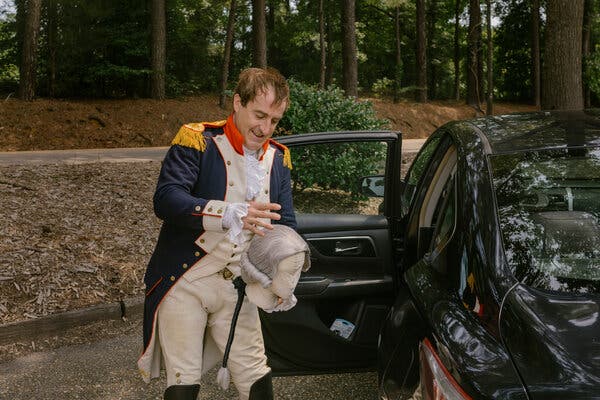
For the Man Who Plays Lafayette, It’s a Marquis Event
America’s favorite fighting Frenchman arrived for a farewell tour in 1824. A yearlong commemoration kicks off this week, and the country’s pre-eminent “Lafayette” is ready.
Supported by
Jennifer Schuessler has written frequently about the American Revolution and the people still fighting about it.
On a recent sultry Monday, Mark Schneider pulled up to a stable in Williamsburg, Va., ready to get back to the grind, 18th-century style.
He was already wearing his leather breeches and ruffly linen shirt. After preparing his horse, he went back to the car for his waistcoat, swords, wig and plumed hat, before hoisting himself into the saddle and heading toward a grassy field near the town’s restored colonial-era courthouse.
Tucked in his jacket was a cellphone, for emergencies. He also carried a period-correct flask full of water, for discreet hydration.
“I wouldn’t want people to see the Marquis de Lafayette drinking from a flask and get the wrong idea,” he said.

For the past 25 years, Schneider has worked at Colonial Williamsburg portraying the French aristocrat who arrived in America at age 19 and became a hero of the American Revolution. But for “Marquis Mark,” as friends jokingly call him, this has been an especially historic summer.
He was just back from a battle re-enactment in the Czech Republic, part of his side hustle as an in-demand Napoleon. Now, his sights were on Lower Manhattan, where he will land on Friday to kick off a 13-month 200th-anniversary recreation of Lafayette’s triumphant 1824 farewell tour of the United States.
Crowds will likely fall far short of the estimated 80,000 New Yorkers who lined the streets to see Lafayette, the last surviving major general from the Revolution, who had helped secure the decisive victory at Yorktown. And instead of traveling by horse, Schneider will process along Broadway to ceremonial events at City Hall and elsewhere in a motorized faux-carriage, in deference to city laws restricting horses during the summer heat.
Still, it will be a bucket-list moment, especially for a guy born on Long Island.
“Even though I’m not really the marquis, I’m representing him and landing in this incredible city to much pomp and circumstance and fanfare,” Schneider said. “I’m thrilled.”
During the tour re-creation, four Lafayettes will share the role across hundreds of scheduled events in the 24 states visited by the marquis, who planned to stay five months but stayed for more than a year, traveling 6,000 miles and leaving behind scores of streets, squares, schools and towns named in his honor. But even at 5 foot 6 — about six inches short of the marquis himself — Schneider stands above the field.
“His knowledge is second to none, and he’s the best orator I’ve ever seen,” said Chuck Schwam, the executive director of the group American Friends of Lafayette, which is organizing the tour. “Also, he just looks damned good in the uniform.”
In an old-fashioned biography, Schneider’s rise to the top of the Lafayette world might be cast as destiny. He grew up in Setauket, on the north shore of Long Island, the son of a French mother and American father. The town had been a center of the Revolution-era Culpeper spy ring (the inspiration behind the AMC television drama “Turn”). But Schneider, 54, was more of a French military history nerd, fond of running around the streets in baseball-pant “breeches,” waving a homemade tricolor flag.
“Kids my age loved Batman and Superman,” he said. “I loved Napoleon.”
Partway through college, he enlisted in the U.S. Army, serving as a cavalry scout in a unit that was deployed to Bosnia-Herzegovina. Today’s cavalry, as it happens, does not involve actual horses. He was introduced to riding later, through a girlfriend, while stationed in Germany. It turned out to be “life-changing.”
In 1997, two weeks after his discharge, Schneider (who speaks fluent French) joined the historic trades division at Colonial Williamsburg, working as a brickmaker, sawyer and carpenter while finishing his history degree. He also started riding in the site’s military programs and, two years later, became Lafayette.
“It’s easier to teach people to read lines than teaching them to ride a horse,” he said.
Schneider also joined a local Napoleonic cavalry re-enactment group. After acquiring a hat and coat, he started using his theatrical skills to portray the emperor in educational films, as well as at events commemorating the 200th anniversary of the 1803 Louisiana Purchase. But the first time someone with a French-ish accent called with an invitation to Europe, he hung up, thinking it was a friend playing a joke.
Since then, he has made more than 50 appearances as the emperor across Europe, where there is a long tradition of enormous battle re-enactments but the immersive “living history” portrayals pioneered at Williamsburg are new.
In 2006, for the 200th anniversary of Napoleon’s entry into Berlin, he rode a white stallion through the Brandenburg Gate and delivered an address to an ecstatic crowd (who were apparently unconcerned that the occasion marked a humiliating defeat). Schneider has been presented with the imperial eagles at a pageant in Empress Josephine’s château outside Paris, and will happily share frame-by-frame images of an “epic wreck” while galloping up a slick hillside at a faux Austerlitz.
“I went end over end in front of 20,000 people,” he said.
His film and television credits include about 10 wordless seconds of screen time in Jean-François Richet’s 2018 historical drama “The Emperor of Paris,” which earned him a ranking of No. 27 on Le Figaro’s list of the top 100 onscreen Napoleons — one spot ahead of Joaquin Phoenix in Ridley Scott’s much-maligned 2023 biopic.
But not everyone in France is impressed. In the 2018 documentary “Being Napoleon,” he fends off a trash-talking Parisian lawyer seeking to supplant him as Napoleon at the 200th anniversary re-enactment of Waterloo. Schneider said he found the rivalry “ridiculous.”
“The point is to educate and teach people,” he said. “If you’re going to nitpick on my costume or my ‘Anglo-Saxon’ accent, that’s OK. I know I’m not these characters. I’m just Mark.”
Thomas Jefferson, in a 1787 letter to John Adams, described Lafayette as having “a canine appetite for popularity and fame.” For all his exuberant bonhomie as the marquis, Schneider comes off as low-key and self-deprecating — the kind of guy who is less likely to cite Voltaire than “Anchorman” or “Tropic Thunder” (which he brought up to make a point about Method acting).
Like most fellow interpreters at Williamsburg, Schneider won’t break character to answer visitors’ questions about himself. “We want people to feel like they are going back in time and meeting the individual,” he said.
But everyday life is another story. He recalled the time a woman approached him at the gym while he was doing sit-ups.
“She bent down and asked, ‘Are you the Marquis de Lafayette?’” he said. “It was 6:30 in the morning. I said, ‘Not at the moment.’”
Living history museums, which aim to immerse visitors in a recreated past, are sometimes accused of peddling nostalgic history longer on bonnets, bayonets and butter churning than scholarship. But at Colonial Williamsburg, the portrayals are as meticulously tended as the buildings and clothing (which are almost entirely made on site using 18th-century techniques).
Schneider’s dressing room is crammed with costumes and memorabilia, including multiple Lafayette bobbleheads. But you’ll also find several hundred books, including shelves of biographies (his other roles include the generals Rochambeau and Banastre Tarleton), along with volumes on the French Revolution, the ancien régime, the fighting in Haiti and, of course, horses.
Schneider has saved two decades of handwritten notes about his characters, which he draws on to script his repertoire of about 10 programs. He also keeps lists of potential visitor questions, from the philosophical to the mundane.
“You cannot second guess yourself,” he said. “If someone asks my wife’s name, I can’t be like, ‘Um … Adrienne?’”
In recent years, Colonial Williamsburg’s cast of “nation builders,” as its core historical characters are known, has expanded beyond traditional “founding fathers” to include African Americans, Native Americans and women.
But even before the musical “Hamilton” turned Lafayette into a motor-mouthed rapper, the marquis — an outspoken critic of slavery and advocate for Native Americans, who wrote the first draft of France’s Declaration of the Rights of Man — felt a bit, well, cooler than Washington or Jefferson.
“He was just an incredible individual,” Schneider said. “He was very 21st-century in an 18th-century world.”
Lafayette’s 1824 tour began on the eve of a contentious presidential election, one of only two (so far) decided in the House of Representatives. And organizers of this year’s commemoration, mindful of America’s impending Semiquincentennial in 2026, are promoting it as an inspiring tale of a polarized nation uniting around the rekindled principles of the founding.
Contemporary politics have sometimes complicated the business of being Lafayette. Schneider recalled some tense visitor interactions during the Iraq War, when some Americans were dumping French wine and eating “freedom fries.” But these days, a more common challenge is politely parrying (dubious) claims that a visitor’s ancestor saved the injured Lafayette’s life at the battle of Brandywine.
“You don’t want to make people feel bad,” Schneider said. “You just say, ‘Oh wow – thank you!’”
Ultimately, the point of the job isn’t fame, fortune or frippery, but helping visitors connect with the past.
“It’s about making a difference, not about me getting all these pictures taken and being called the greatest Lafayette, or the greatest Napoleon,” he said. “The greatest ones are lying in their graves. I hope I’m doing them justice.”
Jennifer Schuessler is a reporter for the Culture section of The Times who covers intellectual life and the world of ideas. More about Jennifer Schuessler
The Great Read
Here are more fascinating tales you can’t help reading all the way to the end.
A Tragedy in the Hamptons: Candice and Brandon Miller projected an Instagram-perfect life. But the money to sustain it did not exist.
Bari Weiss Knows What She’s Doing: The founder of The Free Press has built a new media empire by persuading audiences that she is a teller of dangerous truths.
A Right-Wing Miracle Cure: On a far-right platform, one man in chronic pain was led to a “medbed,” a device that followers believed could cure any disease.
Guided by Hand-Drawn Maps: Nostalgic for a time before ubiquitous connectivity, a writer trekked across Switzerland using maps made by people he met along the way.
Betty Gordon Is Not Done: She danced naked at Woodstock. She dated Serpico. Now 93, she may be the world’s most unlikely children’s book author.
Advertisement

